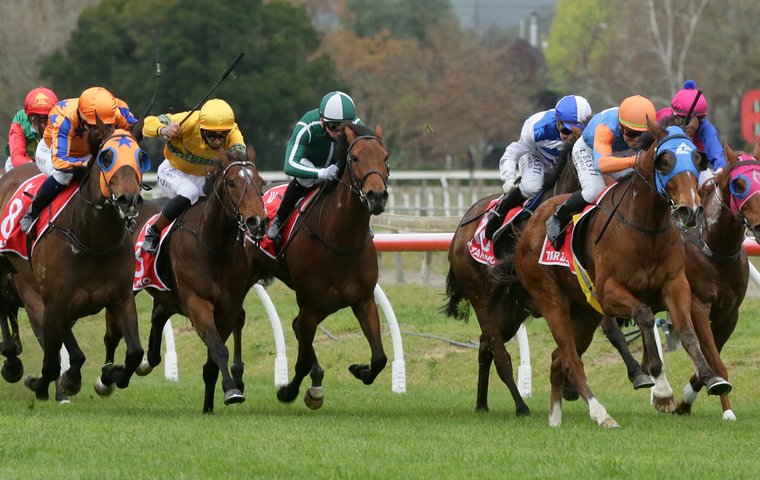
There may have been very little happening in the Northern Hemisphere in the upper echelons of the TRC Global Horse Rankings last week but there was plenty going on down under, particularly as regards the battle to assume the mantle of the great Winx as the leading distaff runner in Oceania.
Key race in New Zealand was the first G1 of the season there, the seven-furlong G1 Tarzino Trophy at Hastings (first leg of the so-called NZ Triple Crown, which is open to older horses). This saw the defeat of the country’s highest-ranked horse, the 5-year-old mare Avantage, who was coming off a prep race win after a break since winning a pair of G1s in the spring.
She finished third to shock 82/1 winner Callsign Mav (a 4-year-old gelding who is a new entry in the rankings at #345 as a result) and Supera (unranked), with second favourite Jennifer Eccles (#83 from #77), winner of the mile-and-a-half New Zealand Oaks in March, back in fourth. Avantage drops 12pts and 11 spots in the rankings to #74.
All this allows ten-time G1 winner Melody Belle – winner of the last two Tarzinos and world #20 as recently as May – to resume top spot among Kiwi runners, at #71. The record-setting mare is still in training at six, having returned home from Sydney after a disappointing run in the G1 Winx Stakes at Randwick. She has options in the G1 Captain Cook Stakes and Zabeel Classic in New Zealand later this year.
Another star Antipodean mare, the Chris Waller-trained Verry Elleegant, had beaten Star Of The Seas, Fierce Impact and Imaging - as well as 11th-placed Melody Belle - in the Winx (1400m) at Randwick last month and started at short odds to repeat the dose in the G1 George Main at the same track over a mile on Saturday.
In the event, Verry Elleegant, who had been runner-up to British raider Addeyyb (currently world #37) in the prestigious Queen Elizabeth, also at Randwick, in April, could finish only fourth in the George Main to Kolding (#113 from #165), with Star Of The Seas again second and Imaging third. Verry Elleegant drops 11 spots to #107.
The runner who now occupies the position as highest-ranked filly or mare down under is the 3-year-old Dame Giselle, a daughter of I Am Invincible who has notched a hat-trick of G2s successes in the past month, all on Winx’s old stomping ground at Randwick. She was at it again on Saturday, taking the Darley Tea Rose Stakes under Tommy Berry for trainers Peter and Paul Snowdon and owners China Horse Club and Bloodstock Australia. Dame Giselle is certainly impressing the TRC algorithm - she has now leapt to world #48 (up from 109 last week), making her the fourth highest-ranked horse in Australia.
Berry was the highest-climbing jockey across the world last week - up 8pts and five places to #27.
Dubawi draws level
In the Northern Hemisphere, the battle between the world’s two top sires raged on. The score was Galileo 2 Dubawi 2, but the Godolphin producer, unseated at the top last week, has moved back alongside his Coolmore rival and shares the #1 spot this week in the overall rankings as our system gauged Dubawi’s winners to be more significant for future rankings purposes (Galileo remains well clear judged by turf-only races, while Dubawi also has a fine record on artificial surfaces).
A reminder here then that TRC Global Rankings blends the volume of a sire’s production (Galileo wins this category, hands down) with efficiency metrics like Impact Value (Dubawi by a clear margin) and head-to-head record (Dubawi, again) to produce a Performance Index measured in points that tries to predict next week’s results in which the sire has a runner. (Impact Value is a smarter way of expressing wins-to-runs ratio because it takes into account the size of the field.)
Using a principled approach from the canon of modern statistical learning, the rankings tries to arrange competitors in such an order that next week’s results will produce the minimum number of so-called rankings violations - races in which a high-rated competitor is defeated by a lower-ranked one.
For now, we prefer to side with Dubawi because the system thinks it is a slightly better bet that his runners will defeat Galileo’s – when the surface of the race is not known. If the system learns the race is on turf, it would switch to preferring the Galileo runner. So, TRC Global Rankings are not evaluating some coarse question like Is Dubawi a better sire than Galileo? That deeper inquisition is best left to other methods, particularly those where recency does not count as it does here. TRC Global Rankings strictly concerns itself with the likely results of near-to-hand races.
Let’s take a look at the raw production numbers of the two sires in 2020. This is a table of the world’s leading sires this year ranked simply by ranking wins (Group/Graded races, plus selected others of commensurate standard):
Leading sires in races which count towards TRC Global Rankings in 2020, ranked by decreasing wins
Once again, Galileo has a clear edge in volume, but we have to care about Strike Rate (SR) to best predict a future result. It’s actually closer than usual, but Dubawi still has an edge of nearly three wins per 100 runs (23% to 20%).
Another individual worthy of mention after last week’s results is Canadian rider Emma-Jayne Wilson, whose triumph in the juvenile G1 Natalma Stakes on Lady Speightspeare at Woodbine helped lift her to #286.


